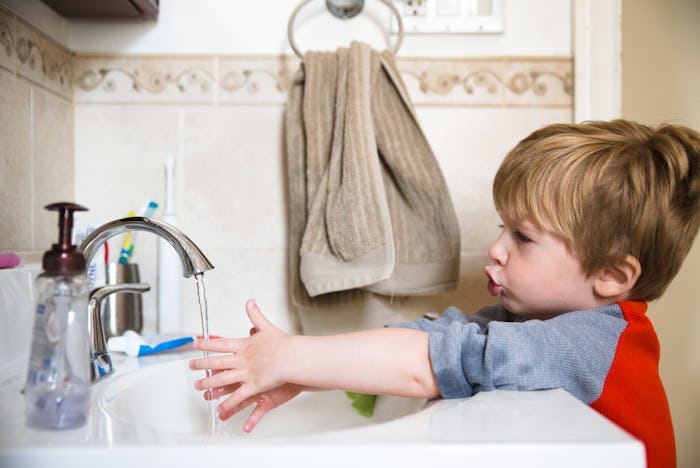Life

Here's How To Unclog Your Kid's Bathroom Sink Without A Plumber
It’s an inevitable and unfortunate rite of passage for parents: your kiddo did a little more than just calmly wash their hands in the bathroom sink, and now it’s clogged and barely draining. Maybe Barbie and her pals took a “bubble bath” in the sink, or somehow paint, glitter, or a bouncy ball ended up lodged in the drain. Too much hair or even floss or toothpaste are also common culprits, but regardless of how it happened, you’re probably frantically wondering how to unclog your kid's bathroom sink. The good news is, it’s not as hard or as gross as it sounds (and at least it’s not the toilet).
Once you know the right steps to take, it's usually pretty simple and quick to unclog a bathroom sink, but one piece of advice from the pros bears mentioning upfront: Don't use chemical decloggers (like Drano or similar products). While they may seem like easy fixes, they typically do more harm than good.
"We replace piping that this product has damaged at a higher cost than it would have been for a homeowner to have their drain cleaned," Jennifer Kettner, owner of Pro Plumb NW, tells Romper. Read on for four things you can try at home before calling a plumber (and one thing you can skip). And more good news: If your kiddo just can't stop playing in the sink, they'll probably love the Hasbro game Plumber Pants.
1Try Boiling Water
Sometimes the solution to a clogged bathroom sink is as simple as boiling some water. For this step, you'll want to allow any excess water in the sink to drain completely (this may take a while if it's already full). Then slowly pour boiling water into the sink, which can help loosen hair and any soap scum that's lodged in there. "Ideally, the water will start to clear the clog almost immediately and you’ll be able to add the rest of the water without filling the basin," per Home Depot.
2Try Some Vinegar
Vinegar is often touted as an elixir for all sorts of things, but it turns out it may help unclog a drain, too. If you've had some success with boiling water but feel like you need a little extra power, you could try pouring a half cup of baking soda down the drain followed by a half cup of white distilled vinegar (per SFGate). Let it sit for 30 minutes, then follow with more boiling water.
"This method could help with a kitchen sink or bathroom clog that's due to soft blockage like grease or built-up soap," Kettner tells Romper. "The hot water will melt the grease and the baking soda and vinegar mix could emulsify a fatty back-up. Those could always be tried before calling in a professional to clear the line. They are definitely safe to use on your plumbing and if it happens to work, then great!"
3Try A Plumber's Snake (Aka An Auger)
A plumber's snake (also called an auger) is a great tool for loosening the clog at its source. There are also shorter plastic snakes, specifically designed to pull hair out of the drain (a gross reality), that can be used if you suspect the problem isn't too deep. Kettner suggests using an actual auger designed for unclogging instead of a wire hanger or other DIY options.
You can also try a sink plunger if you have one on-hand (they're usually smaller than other plungers). Place a damp washcloth over the drain opening to seal it, then plunge up and down for about 20 seconds, per Family Handyman. If it worked, the water should immediately start to swirl down the drain.
4Clear The P-Trap
"When we are at a customer's home that has a clogged sink we typically will pull the P-trap to clear it out," Kettner tells Romper. "This is 99% of the time where a clog would be."
The "P-trap" is the U-shaped part of the pipes under the sink. If you are taking it apart yourself, make sure to have a bucket ready as water and other gunk is likely to fall out. You may need to use an auger to feel around for the clogged area, even after you remove the part.
"Depending on the type of pipes that you have it may be difficult to remove and replace the P-trap," Kettner tells Romper, so if you're unsure, it's best to call a professional.
5Skip The Chemical Cleaners And Call A Plumber
It's tempting to want a quick solution to a clogged drain, but chemical decloggers can really mess up your pipes.
These products use a "chemical reaction to eat away your blockages, but [they also] eat away at your plumbing. We have been to homes that have ABS (plastic) piping and found that the heat created by Drano in their waste lines has bowed their piping and created bellies and even holes," Kettner tells Romper. Cast iron piping can also be damaged.
"A clogged drain should be cleared with the proper equipment instead of a chemical to reduce the risk of damaging your existing plumbing," Kettner says. "Often a drain that needs repeated clearing should be replaced or upsized to compensate for its current load."
Expert:
Jennifer Kettner, owner of Pro Plumb NW
This article was originally published on